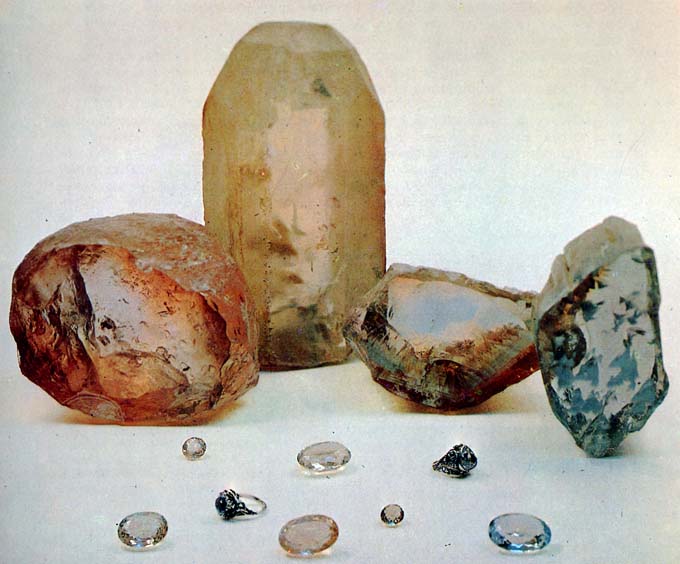Topaz - blue, yellow, wine and polychromatic minerals
Topaz
Chemical formula: Al2 [SiO4] (F, OH) 2.
Crystal system: orthorhombic.
Types: Murzinskaya - isometric habit, with a well-developed prism and pinacoids, characteristic brink dipyramid and dihedral; Ilmensky - barrel, pinacoid narrowed rows dipyramids, a prism (110) determines the shape of hexagonal crystals; Korosten - well-developed side of the prism, no pinacoid; Sherlovogorskaya and borschovsky - elongated crystal habit uniformly developed prism and dihedron.
Colour: colorless, watery-transparent, less blue, blue, blue-green, wine-yellow, brown, pink. Usually bright colors. Dark topaz does not happen.
Hardness: 8.
Density: 3,52- 3,57 g / cm3 (increases in areas with colorless and blue tones).
Cleavage: perfect on pinakodu.
Fracture: not by cleavage conchoidal.
Shine: glass.
Transparency: transparent.
Refraction: ng = 1,618- 1,638, nm = 1,610- 1,633, np = 1,607- 1,629.
Birefringence: 0,009-0,010.
Dispersion: 0.014.
Pleochroism: in pink, wine-yellow topaz - a distinct, in blue - weak.
Absorption: 682.8 nm.
Luminescence: brown, purple and yellow.

Topaz. In the foreground is the "Golden Polesie" (5,380 kg); "Fairy Tale" (2,810 kg); L. Fersman (2,110 kg).
Vertical Crystal - Topaz (12.710 kg). Ukraine
Pliny the Elder in the "Natural History" mentions gold stone mined on about. Topaznoe in the Red Sea, which he described as topaz. And despite the fact that Pliny described Topaz turned chrysolite, as evidenced by archaeological excavations in Alexandria, for all the golden-yellow and brown stones retained this name. Later, other types of topaz were discovered.
Well-formed crystals of topaz found in the cavities miarolonosnyh (chamber) pegmatites Ukraine Borschovochnogo ridge in Baikal, Pamir, in greisens Transbaikalia, as well as cavities drusy the Urals. Form crystal faces are usually perfect, size is often larger. So, in 1840, in Transbaikalia Borschovochnom Ridge found transparent wine yellow topaz weighing 13.1 kg in 1911 in the Ural mines Mokrusha - poorly transparent greenish blue, in the form of regular crystals, weighing about 32 kg, in 1966 , at the Volyn deposit (Ukraine) - one of the world's largest, weighing 117 kg.
More rare and accordingly valuable - blue topaz, then intensely colored pink, yellow wine. Colorless and pale-colored valued less. topaz cost depending on the size of the stones is not growing like a diamond, and other more valuable gems as well as the size of the crystals of topaz is usually significant. Some topaz fade with prolonged effect of sunlight, change color upon heating and irradiation.
Nature color two-color topaz Volyn deposit rather complex and caused by AN Platonov, different types of color centers (brown shades - with hole centers O, pink and blue - with an impurity centers Ti3 +). Many gems (diamond leucosapphire, aquamarine, tourmaline, zircon, fluorite, and others.), Especially in small samples or cutting, are similar to topaz. Thus, the Portuguese crown Topaz (1680 carats) of extraordinary beauty and purity for a long time was considered the diamond and therefore was named "big diamond".
High hardness and perfect cleavage topaz impede his cut. When processing a stone attached to an oval stupenchatuyu- topaz, diamond rarer and combined forms. Topaz with inclusions are processed in the form of cabochons.
The main areas placement of deposits topaz CIS - Ukraine, the Urals and Trans-Baikal. At present, mining of topaz jewelry is made by means of underground mining, simultaneously with quartz on a single industrial field of chamber pegmatites in Ukraine. Famous early deposits of semi-precious bandwidth Ural Mountains and greisens Sherlovaya pegmatites Borschovochnogo Ridge (Baikal), described in the works Fersman, not exploited, even though the prospects of their being exhausted.
Popular gems, which are represented in the CIS (ex. USSR)
- Diamond - the hardest and one of the most expensive in the world of minerals
- Alexandrite (chrysoberyl) - one of the rarest and original stones
- Beryl (group beryl) - Heliodorus, emeralds, aquamarine, morganite
- Turquoise - blue and green gem of the East
- Garnet (Group garnets) - popular cheap gems
- Jade - a popular stone that was used as early as the Neolithic
- Pearls - a traditional and favorite piece of jewelry of the Slavs
- Quartz (quartz group) - is extremely popular in mineral collections
- Aluminium oxide (corundum group) - colorless corundum, rubies and sapphires
- Lapis - blue stone high blue mountains of the Pamirs and Afghanistan
- Malachite - Ural malachite is considered the best in the world
- Jade - the sacred green stone of Chinese emperors
- Feldspars - labradorite, moonstone, sunstone, amazonite
- Rhodonite (Orlets) - beautiful pink stone of the Urals, Russia Stone
- Topaz - blue, yellow, wine and polychromatic minerals
- Tourmaline - original gems of all colors and shades
- Fluorite - a valuable mineral used in the industry
- Peridot - magmatic mineral, transparent garnet olivine
- Spinel has more recently been highlighted in a separate class
- Amber (fossilized resin of ancient trees) - frozen time
- Jasper - unique mineral with a broad color palette


Comments
Commenting, keep in mind that the content and the tone of your messages can hurt the feelings of real people, show respect and tolerance to his interlocutors, even if you do not share their opinion, your behavior in terms of freedom of speech and anonymity offered by the Internet, is changing not only virtual, but real world. All comments are hidden from the index, spam control.